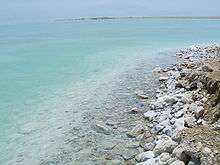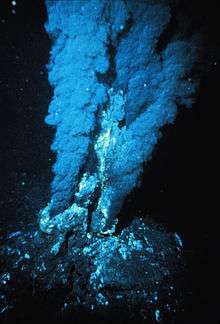Extreme environment
An extreme environment contains conditions that are hard to survive for most known life forms. These conditions may be extremely high or low temperature or pressure; high or low content of oxygen or carbon dioxide in the atmosphere; high levels of radiation, acidity, or alkalinity; absence of water; water containing a high concentration of salt or sugar; presence of sulphur, petroleum, and other toxic substances.
Examples of extreme environments include the geographical poles, very dry deserts, volcanoes, deep ocean trenches, upper atmosphere, Mt Everest, outer space, and the environments of every planet in the Solar System except the Earth. Any organisms living in these conditions are often very well adapted to their living circumstances, which is usually a result of long-term evolution. Physiologists have long known that organisms living in extreme environments are especially likely to exhibit clear examples of evolutionary adaptation because of the presumably intense past natural selection they have experienced.[1]
On Earth
The distribution of extreme environments on Earth has varied through geological time. Humans generally do not inhabit extreme environments. There are organisms referred to as extremophiles that do live in such conditions and are so well-adapted that they readily grow and multiply.
Beyond Earth
Most of the moons and planets in the Solar System are also extreme environments. Astrobiologists have not yet found life in any environments beyond Earth, though experiments have shown that tardigrades can survive the harsh vacuum and intense radiation of outer space. The conceptual modification of conditions in locations beyond Earth, to make them more habitable by humans and other terrestrial organisms, is known as terraforming.
Types of extreme environments
Among extreme environments are alkaline, acidic, extremely cold, extremely hot, hyper-saline, places without water or oxygen, and places altered by humans, such as mine tailings or oil impacted habitats. [2] [3]
- Alkaline: broadly conceived as natural habitats above pH 9 whether persistently, or with regular frequency or for protracted periods of time.
- Acidic: broadly conceived as natural habitats below pH 5 whether persistently, or with regular frequency or for protracted periods of time.
- Extremely cold: broadly conceived habitats periodically or consistently below -17 °C either persistently, or with regular frequency or for protracted periods of time. Includes montane sites, polar sites, and deep ocean habitats.
- Extremely hot: broadly conceived habitats periodically or consistently in excess of 40 °C either persistently, or with regular frequency or for protracted periods of time. Includes sites with geological thermal influences such as Yellowstone and comparable locations worldwide or deep-sea vents.
- Hypersaline: (high salt) environments with salt concentrations greater than that of seawater, that is, >3.5%. Includes salt lakes.
- Under pressure: broadly conceived as habitats under extreme hydrostatic pressure — i.e. aquatic habitats deeper than 2000 meters and enclosed habitats under pressure. Includes habitats in oceans and deep lakes.
- Radiation: broadly conceived as habitats exposed to abnormally high radiation or of radiation outside the normal range of light. Includes habitats exposed to high UV and IR radiation.
- Without water: broadly conceived as habitats without free water whether persistently, or with regular frequency or for protracted periods of time. Includes hot and cold desert environments, and some endolithic habitats.
- Without oxygen: broadly conceived as habitats without free oxygen - whether persistently, or with regular frequency, or for protracted periods of time. Includes habitats in deeper sediments.
- Altered by humans, i.e. anthropogenically impacted habitats. Includes mine tailings, oil impacted habitats, and pollution by heavy metals or organic compounds.
Picture gallery
-

Atmosphere and Universe
-

High salinity of the Dead Sea
See also
- Adaptation
- Ecology
- Ecophysiology
- Evolutionary physiology
- Extreme environment clothing
- Extremophile
- LExEN (Life in Extreme Environments)
- Natural environment
References
"Extreme Environment." Microbial Life. N.p., n.d. Web. 16 May 2013.
- ↑ Garland, Jr., T., and P. A. Carter. 1994. Evolutionary physiology. Annual Review of Physiology 56:579–621.
- ↑ "Types of Extreme Environments". NSF. Retrieved 16 May 2013.
- ↑ "Extreme Environments". PeckHart Landscaping inc. Retrieved 17 May 2013.



